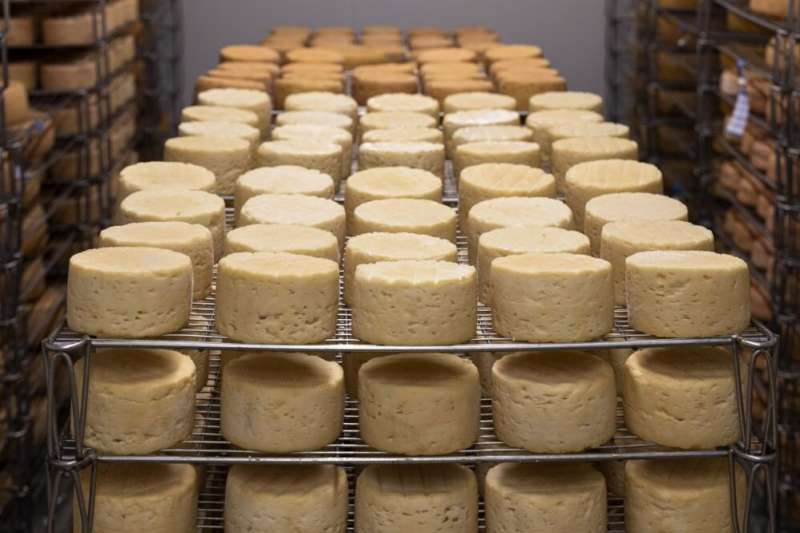Bacterial battle: How protective cultures can protect us from food-borne pathogens in cheese

Cheese is a simple product. It usually only consists of milk, enzymes, salt, and bacteria that give the cheese its form and flavor.
But this simplicity, free of preservatives found in other foods, leaves it vulnerable to hosting pathogens.
"It's a huge risk because if there are pathogenic bacteria in raw milk and you make cheese from that milk, they can propagate and that can cause illness," says Dennis D'Amico, associate professor of dairy foods in the College of Agriculture, Health and Natural Resources.
Federal regulations dictate that cheese producers cannot use the kinds of additives found in foods like deli meats to counteract this danger. One thing they can use, however, is bacterial cultures.
In the cheese production process, cheese makers use starter bacterial cultures to turn milk into cheese. In a recent study published in LWT, D'Amico found other bacterial cultures, known as protective cultures, can fight pathogens and prevent them from causing illness by hampering their ability to infect someone at several key points.
In previous studies, D'Amico screened protective cultures to determine which could potentially be effective against common pathogens like Listeria, E. coli, or Salmonella. His lab also screened to tell if these protective cultures would interfere with the starter cultures.
This research is among the first peer-reviewed studies to provide cheese producers with definitive evidence about how these cultures work.
Through this work, D'Amico identified three commercially available protective cultures with the highest chance of being effective against Listeria monocytogenes, the foodborne pathogen responsible for listeriosis.
Listeriosis can have life-threatening effects for those in high-risk groups, such as immunocompromised individuals and pregnant women. The pathogen has a 20–30% mortality rate, making it a significant public health concern.
Choosing from commercially available strains was an important consideration as, otherwise, cheese makers would have a difficult, if not impossible, time adopting D'Amico's findings into their process.
D'Amico used one culture of Lactococcus lactis (LLN), and two different cultures of Lactiplantibacillus plantarum (LP and LPP).
D'Amico conducted a previous study showing that using a high concentration of protective cultures can effectively kill pathogens. In this study, D'Amico used significantly higher concentrations of the pathogens than a person would normally consume to allow the pathogen to survive long enough to study the infection process.
Bacteria change the way they behave when they're in the presence of other, similar bacteria and can produce antimicrobial metabolites. When a pathogenic bacterium detects the presence of these cultures and their metabolites it enters a kind of "fight or flight" mode. The pathogen turns its focus to expressing genes important to surviving the competitor and turns off many of the nonessential functions that allow it to cause illness.
"Evolutionarily, those are their competitors," D'Amico says. "Typically [a protective culture's] effect is limited to a certain group of pathogens."
In order to get sick from eating something contaminated with Listeria, the pathogen needs to survive the inhospitable environment of the gastrointestinal tract. Then, it needs to attach to colon cells. Finally, it needs to enter those cells and cross the epithelial cell lining. Disrupting any of these steps will help prevent illness even if the pathogen doesn't die.
D'Amico found protective cultures were effective at stopping Listeria at key points in the infection process. Both of the Lactiplantibacillus plantarum cultures disrupted Listeria's ability to survive the gastrointestinal tract.
There was not a significant impact on the pathogen's ability to adhere to cells. However, LLN and LPP significantly reduced the pathogen's ability to invade colon cells and all three cultures disrupted transepithelial translocation, where the pathogen crosses the epithelial barrier by moving between the cells.
In a Food Research International publication, D'Amico establishes other potential benefits to adding these cultures.
In theory, if someone regularly eats a product with these protective cultures, they would become part of their gut microbiome and provide probiotic protection against Listeria infection if they encountered it in another food product.
Now, D'Amico is working to help producers determine how to make sure the protective cultures perform effectively in practice.
"Producers are trying their best to make safe products," D'Amico says. "But their hands are kind of tied without solutions like this."
More information: Sulaiman F. Aljasir et al, Probiotic potential of commercial dairy-associated protective cultures: In vitro and in vivo protection against Listeria monocytogenes infection, Food Research International (2021). DOI: 10.1016/j.foodres.2021.110699
Provided by University of Connecticut




















